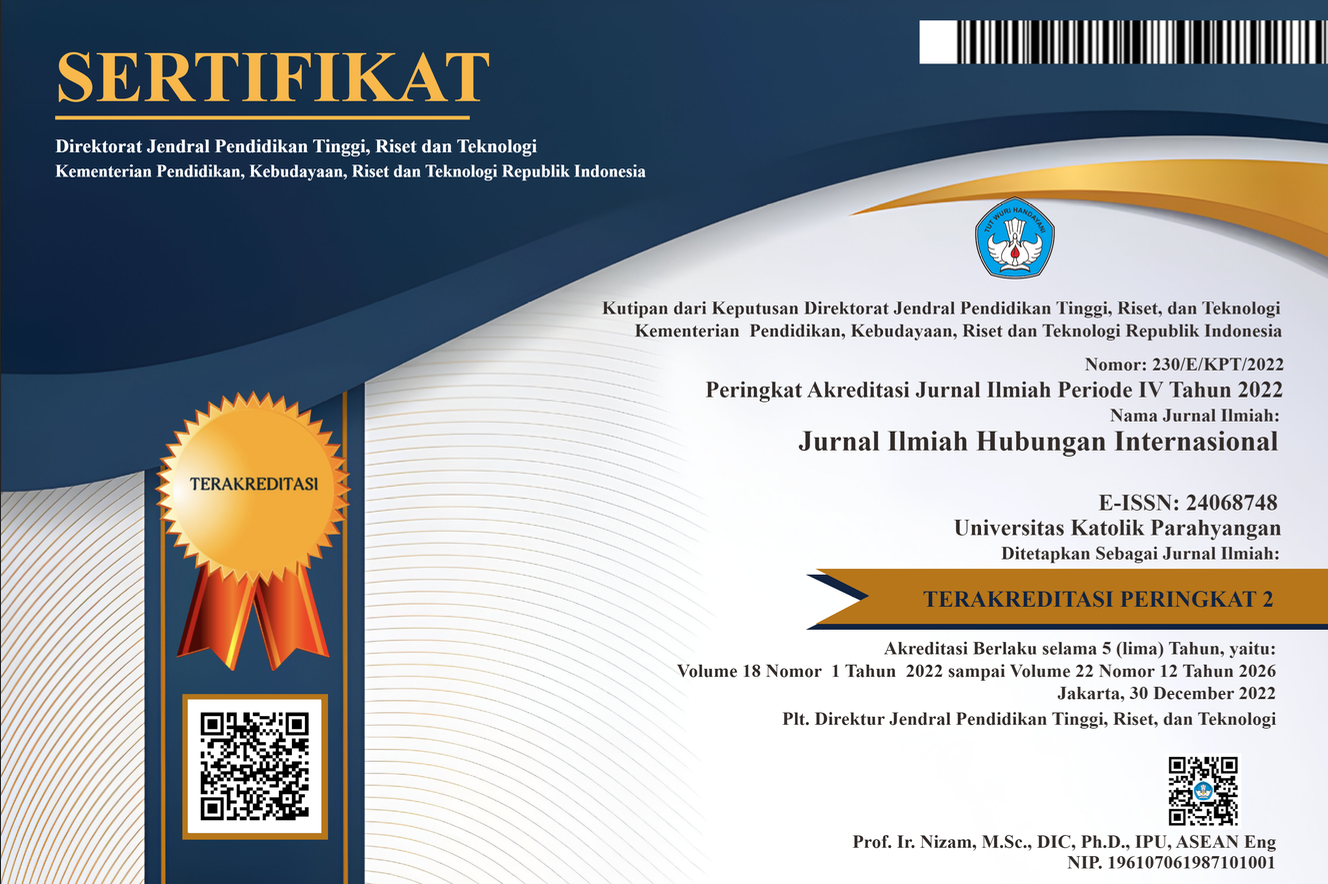Pengaruh Militer Dalam Sistem Politik Myanmar Terhadap Diskriminasi Etnis Rohingya Pada Tahun 2017
DOI:
https://doi.org/10.26593/jihi.v15i1.3117.27-39Keywords:
Military, Political System, RohingyaAbstract
This paper aims to discuss the extent to which the influence of the military in the political system in Myanmar related to cases of prosecution of ethnic Rohingya in 2017. Myanmar's government through the military is considered to use violence and discrimination against Rohingya ethnic groups resulting in thousands of casualties and the ethnic Rohingya fled to neighboring countries. This research was conducted to assess the role of the military in the Myanmar government system because under the 2008 Constitution, the military had a seat of 25 percent in the Myanmar parliament and had a number of authorities in the political system. This can be considered as a trigger for the military's aggressiveness towards Rohingya because of military representatives who have existence in the Myanmar parliament. The author uses concordance theory and the concept of new professionalism of internal security and national development in analyzing related phenomena. The results of this study indicate the existence of military influence in the Myanmar government because under the constitution, the military controls three strategic departments, namely Defense, Internal Affairs and Border. The military also holds full control of the armed forces, police and security forces, thus demonstrating the military role in Myanmar's policies regarding prosecution of the ethnic minority Rohingya.
References
Amnesty Internasional. (2017). Myanmar: Aung San Suu Kyi ‘burying her head in the sand’ about Rakhine Horrors. www.amnesty.org, diakses pada 28 Maret 2018.
Amnesty Internasional. (2017). “Terpenjara Tanpa Atap”: Apartheid Di Negara Bagian Rakhine Di Myanmar. https://www.amnesty.org, diakses pada 28 Maret 2018.
Apriyanti, Devi. (2014). “Reformasi Politik dan Ekonomi di Myanmar Pada Masa Pemerintahan Presiden U Thein Sein (2011-2013).” Jurnal Online Mahasiswa (JOM) Fisip Vol. 1, No. 2, (Oktober 2014). https://jom.unri.ac.id, diakses pada 28 Maret 2018.
Berg, John Richard. (2016). “Insurgents to Presidents: Contemporary Civil-Military Relations in Brazil, El Salvador, and Uruguay.” Thesis, Monterey, California: Naval Postgraduate School. https://calhoun.nps.edu, diakses pada 07 April 2018.
Budiardjo, Miriam. (2001). Dasar-dasar Ilmu Politik. Jakarta: PT. Gramedia Pustaka Utama.
Egreteau, Renaud (2017). Parliamentary Development in Myanmar - An Overview of the Union Parliament, 2011-2016. Yangon: The Asia Foundation, https://reliebweb.int, diakses pada 28 Maret 2018.
Kristiadi, J. (2001). “Profesionalisme TNI di Tengah Transisi Politik”. Jurnal Antropologi Universitas Indonesia. http://journal.ui.ac.id, diakses pada 07 April 2018.
Lunn, Jon & Harari, Daniel. (2018). “Burma: January 2018 Update.” Briefing Paper, No. 7901, 9 (January 2018). http://www.parliament.uk/commons-library, diakses pada 07 April 2018.
Muslina. (2016). “Upaya UNDP (United Nations Development Programme) Dalam Memajukan Demokrasi Di Myanmar.” Jurnal Online Mahasiswa (JOM) FISIP, Vol. 3, No. 2, (Oktober 2016). https://jom.unri.ac.id, diakses pada 28 Maret 2018.
Mendoza, Laura Baron. (2017). “The War Report 2017 - Myanmar: A Battle For Recognition.” Research of Geneva Academy, Academy of International Humanitarian Law and Human Rights. https://www.geneva-academy.ch, diakses pada 28 Maret 2018.
Myoe, Maung Aung. (2017). “Emerging Pattern Of Civil-Military Relations In Myanmar”, Southeast Asian Affairs, (hlm. 259-270). https://www.researchgate.net, diakses pada 28 Maret 2018.
Pujayanti, Adirini. (2017). “Indonesia dan Tragedi Kemanusiaan Rohingya”. Majalah Info Singkat Hubungan Internasional, Vol. 9, No. 17, September 2017. www.puslit.dpr.go.id, diakses pada 28 Maret 2018.
Raco, J.R. (2010). Metode Penelitian Kualitatif - Jenis, Karakteristik, dan Keunggulannya. Jakarta: PT. Gramedia Widiasarana Indonesia.
Revolusi, Alfi et.al. (2013). “Faktor-faktor Penyebab Konflik Etnis Rakhine dan Rohingya di Myanmar Tahun 2012”. Artikel Ilmiah Hasil Penelitian Mahasiswa Universitas Jember. http://repository.unej.ac.id, diakses pada 28 Maret 2018.
RFA (Radio Free Asia). (2017). “Myanmar Military Chief Defends Crackdown Against Rohingya in Rakhine State”, www.rfa.org, diakses pada 29 Maret 2018.
Schiff, Rebecca L. (2009). The Military and Domestic Politics: A Concordance Theory of Civil-Military Relations. New York: Routledge.
Siddiqui, Usaid. (2017). “The Rohingya: The Latest Massacre in a Violence-Filled History.” Al Jazeera Centre for Studies. http://studies.aljazeera.net, diakses pada 29 Maret 2018.
Sohel, Md. Salman. (2017). “The Rohingya Crisis in Myanmar: Origin and Emergence.” Saudi Journal of Humanities and Social Sciences, Vol. 2, No. 11A. http://scholarsmepub.com, diakses pada 29 Maret 2018.
Stokke, Kristian., Vakulchuk, Roman & Øverland, Indra. (2018). “Myanmar: A Political Economy Analysis”. Oslo: Norwegian Institute of International Affairs, www.nupi.no, diakses pada 29 Maret 2018.
Thontowi, Jawahir. (2013). “Perlakuan Pemerintah Myanmar terhadap Minoritas Muslim Rohingya Perspektif Sejarah dan Hukum Internasional”. Jurnal Pandecta, Vol. 8, No. 1, (Januari 2013). http://journal.unnes.ac.id, diakses pada 29 Maret 2018.
Thuzar, Moe. (2017). “Understanding Democracy, Security, and Change in Post-2015 Myanmar.” The Journal of Asia Studies Vol. 22, No. 1. http://aas2.asian-studies.org, diakses pada 28 Maret 2018.
Waluyo, Tri Joko. (2013). “Konflik Tak Seimbang Etnis Rohingya dan Etnis Rakhine di Myanmar. Jurnal Transnasional, Vol. 4, No. 2. https://ejournal.unri.ac.id, diakses pada 28 Maret 2018.
Downloads
Published
How to Cite
Issue
Section
License
This journal uses Creative Commons license (CC BY). We allow readers to read, download, copy, distribute, print, search, or link to the full texts of its articles and allow readers to use them for any other lawful purpose. The author must be aware that the article copyrights will be fully transferred to Jurnal Ilmiah Hubungan Internasional only if the article is accepted to be published in the journal through signing of the Copyrights Transfer Agreement. Authors are allowed to resend their manuscript to another journal or intentionally withdraw the manuscript only if both parties (JIHI and Authors) have agreed on the related issue. Once the manuscript has been published, authors are allowed to use their published article under Jurnal Ilmiah Hubungan Internasional copyrights.








